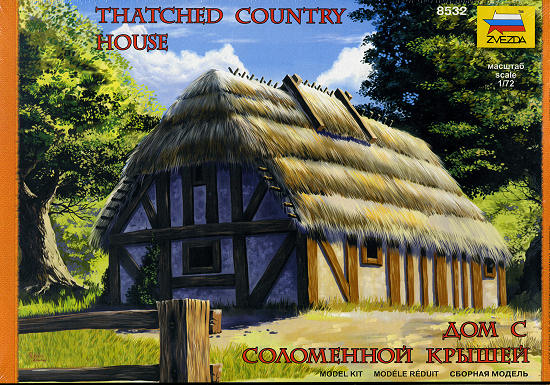
Zvezda 1/72 Thatched Country House
| KIT #: | 8532 |
| PRICE: | About $20.00 |
| DECALS: | No options |
| REVIEWER: | Scott Van Aken |
| NOTES: | Two complete kits |

| HISTORY |
Thatching is the craft of covering a roof with dry vegetation such as straw, water reed, sedge, rushes and heather, layering the vegetation so as to shed water away from the inner roof. It is probably the oldest roofing material and has been used in both tropical and temperate climates. Thatch is still employed by builders in developing countries, usually with low-cost, local vegetation. By contrast in some developed countries it is now the choice of well-to-do people who want their home to have a rustic look.
The tradition of thatching has been passed down from generation to generation for thousands of years. Few descriptions of the building techniques exist, especially in tropical regions.
In equatorial countries thatch is the prevalent local material for roofs, and often walls. There are diverse building techniques from the Hawaiian Hale shelter made from the local ti leaves and pili grass of fan palms to the Na Bure Fijian home with layered reed walls and sugar cane leaf roofs and the Kikuyu tribal homes in Kenya. The colonization of indigenous lands by Europeans greatly diminished the use of thatching.
Records of European thatch date back to before the Middle Ages, when the first villages were established. The creation of villages brought with it the need for readily available, inexpensive, and durable building material, such as thatch. “Thatch houses built in close proximity helped to account for the frequent and disastrous fires that swept through the narrow streets of medieval cities.” Eventually the authorities wrote the Ordinance of 1212, arguably the first building regulation in force in London, prohibiting the building of new thatch roofs and demanding the whitewashing of existing ones with plaster daub.
Early settlers to the New World used thatch as far back as 1565. Native Americans had already been using thatch for generations. When settlers arrived in Jamestown, Virginia in 1607, they found Powhatan Indians living in houses with thatched roofs. The colonists used the same thatch on their own buildings. In the early years of the 19th century thatching was in decline. The commercial production of Welsh slate had begun in 1820 and the mobility which the canals and then the railways made possible meant that other materials became readily available. To compound this, the Napoleonic Wars raised the price of wheat and straw to a prohibitive level in Europe. The number of thatchers declined, as the tradition became regarded as unfashionable.
Technology in the farming industry has had a negative impact on the popularity of thatching. Use of the material declined following the First World War in particular, and with the invention of the combine harvester and the need to develop shorter stemmed varieties of wheat, the long straw once produced was no longer available. The increased loss of water plants and wildlife occurred with the shift from open ponds to cattle troughs and piped water for animals. With it came the decline in availability of rushes, and other wetland vegetation used in thatching.
With renewed interest in historic architecture and the trend towards using more sustainable materials, thatching is once again in the ascendancy.
| THE KIT |
 Because there are two houses, the sprues are duplicated so only one set is shown. This consists of a tan sprue that is mostly roof parts, a grey sprue that is walls, and a dark brown sprue that is the exterior wall trim. Each of the wall segments has areas scribed away on the inside for doors or windows. The kit provides a section of clear acetate which would be more appropriate to a more 'modern' thatched house, but then again, it could have been a country gentleman's getaway house and they could afford glass.
Because there are two houses, the sprues are duplicated so only one set is shown. This consists of a tan sprue that is mostly roof parts, a grey sprue that is walls, and a dark brown sprue that is the exterior wall trim. Each of the wall segments has areas scribed away on the inside for doors or windows. The kit provides a section of clear acetate which would be more appropriate to a more 'modern' thatched house, but then again, it could have been a country gentleman's getaway house and they could afford glass. | CONCLUSIONS |
Even if you are not into wargaming, this pair of houses would not look out of place on the Russian steppes or even in central and western Europe during WWII. It is a nice kit and I'm pleased that kit makers are offering items like this.
| REFERENCES |
October 2008
My thanks to www.dragonmodelsusa.com for the review kit. Get yours at your local shop or order on-line. If you would like your product reviewed fairly and fairly quickly, please contact the editor or see other details in the Note to Contributors.